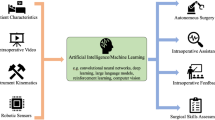Abstract
Introduction
Single-incision laparoscopic surgery (SILS) is limited by the coaxial arrangement of the instruments. A surgical robot with wristed instruments could overcome this limitation, but the arms often collide when working coaxially. This study tests a new technique of “chopstick” surgery to enable use of the robotic arms through a single incision without collision.
Methods
Experiments were conducted utilizing the da Vinci S® robot (Intuitive Surgical, Inc., Sunnyvale, CA) in a Fundamentals of Laparoscopic Surgery (FLS) box trainer with three laparoscopic ports (1 × 12 mm, 2 × 5 mm) introduced through a single “incision.” Pilot work determined the optimal setup for SILS to be a triangular port arrangement with 2-cm trocar distance and remote center at the abdominal wall. Using this setup, five experienced robotic surgeons performed three FLS tasks utilizing either a standard robotic arm setup or the chopstick technique. The chopstick arrangement crosses the instruments at the abdominal wall so that the right instrument is on the left side of the target and the left instrument on the right. This results in separation of the robotic arms outside the box. To correct for the change in handedness, the robotic console is instructed to drive the “left” instrument with the right-hand effector and the “right” instrument with the left. Performances were compared while measuring time, errors, number of clutching maneuvers, and degree of instrument collision (Likert scale 1–4).
Results
Compared with the standard setup, the chopstick configuration increased surgeon dexterity and global performance through significantly improved performance times, eliminating instrument collision, and decreasing number of camera manipulations, clutching maneuvers, and errors during all tasks.
Conclusion
Chopstick surgery significantly enhances the functionality of the surgical robot when working through a small single incision. This technique will enable surgeons to utilize the robot for SILS and possibly for intraluminal or transluminal surgery.





Similar content being viewed by others
References
Raman JD, Cadeddu JA, Rao P, Rane A (2008) Single-incision laparoscopic surgery: initial urological experience and comparison with natural-orifice transluminal endoscopic surgery. BJU Int 101:1493–1496
Tacchino R, Greco F, Matera D (2009) Single-incision laparoscopic cholecystectomy: surgery without a visible scar. Surg Endosc 23:896–899
Saber AA, Elgamal MH, Itawi EA, Rao AJ (2008) Single incision laparoscopic sleeve gastrectomy (SILS): a novel technique. Obes Surg 18:1338–1342
Raman JD, Bagrodia A, Cadeddu JA (2009) Single-incision, umbilical laparoscopic versus conventional laparoscopic nephrectomy: a comparison of perioperative outcomes and short-term measures of convalescence. Eur Urol 55(5):1198–1204
Kommu SS, Kaouk JH, Rane A (2009) Laparo-endoscopic single-site surgery: preliminary advances in renal surgery. BJU Int 103(8):1034–1037
Kaouk JH, Goel RK, Haber GP, Crouzet S, Stein RJ (2009) Robotic single-port transumbilical surgery in humans: initial report. BJU Int 103:366–369
Disclosures
Drs. Rohan A. Joseph, Alvin C. Goh, Sebastian P. Cuevas, Michael A. Donovan, Matthew G. Kauffman, Nilson A. Salas, Brian J. Dunkin have no conflicts of interest or financial ties to disclose. Dr. Brian Miles is a proctor for Intuitive Surgical, Inc.
Author information
Authors and Affiliations
Corresponding author
Appendix 1. FLS manual skills score sheet
Appendix 1. FLS manual skills score sheet
-
1.
PEG transfer (timing starts once first object is grasped, ends after last PEG is transferred)
Time to complete: seconds
PEGS not transferred:
-
2.
Pattern cut (timing starts when gauze is grasped and ends when circle is cut completely)
Time to complete: seconds
Area of penalty: squares covered
-
3.
Intracorporeal knot (timing starts when you see instruments inside the box, ends when both sutures are cut)
Time to complete: seconds
Penalty: mm from edge of predrawn dots
Security of knot.
Rights and permissions
About this article
Cite this article
Joseph, R.A., Goh, A.C., Cuevas, S.P. et al. “Chopstick” surgery: a novel technique improves surgeon performance and eliminates arm collision in robotic single-incision laparoscopic surgery. Surg Endosc 24, 1331–1335 (2010). https://doi.org/10.1007/s00464-009-0769-8
Received:
Accepted:
Published:
Issue Date:
DOI: https://doi.org/10.1007/s00464-009-0769-8




